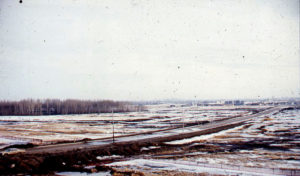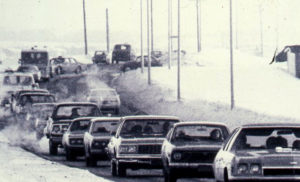People had just barely started moving into Mill Woods when it was almost wiped out in one of the scariest days in Edmonton’s history. On March 2, 1979, an estimated 19,000 Edmontonians were evacuated from homes, schools and businesses after a pipeline ruptured in Mill Woods. It was one of the largest peacetime evacuations in Canadian history at that time.
No one was killed, but one man, Peter Clark, was severely burned. Clark was driving a delivery truck that went through a cloud of what he thought was mist, but was actually propane. His truck stalled and all of a sudden, flames were all around him.
“I knew I had to get out of there,” Clark said in a 2019 interview for the Edmonton Journal. “You know, the flames, everything is coming in. So I jumped out of the vehicle. All I could see was flames. All I could hear was flames. I knew I didn’t want to go any further into this fire, so I ran back, putting my head in the snow… I owe my life to this young fellow… who started yelling at me, letting me know I was out of the fire. I couldn’t tell because I was all in flames. And he’s the one who took me to hospital and rescued my life.” Clark was in hospital for nine months.
It was the start of a long, tense and frightening day. The explosion sparked by Clark’s engine burned for 16 hours. Cec Purves was Edmonton’s mayor at the time. He talked about his experience with the Mill Woods Living Heritage project:
“That was scary. That’s when I was baptized under fire and realized that a lot of decisions came down to me, whether I liked it or not… All of the experts were telling us what would happen with this gas, that it would do certain things, but it wasn’t doing that. And it was going through the sewers. It was just rolling through, like a rolling thunder through those sewers. There were concerns that if this blows up, the whole of Mill Woods will go up.”
“What people don’t realize is that some of the sewer pipes [are so large that] you can drive a bus through,” Purves continues. “That’s how big they are… The experts were saying this will all come out, but what was happening was that manhole covers were being blown, gas was coming up in people’s toilets. The emergency people were saying this is a disaster waiting to happen. If this ever lights up, this will be an underground fire that will go through houses and everything else. So we evacuated Mill Woods. I said let’s do it… get the police in there and the fire department in there and clean them out. So that is what we did.”
The evacuation lasted 22 hours and ended when the gas dissipated.
In the wake of that terrible day, several entities realized that changes needed to be made. Barry Lamb was the deputy fire chief at the time. “We didn’t have access to everything like we would nowadays,” he said in a 2019 interview for the Edmonton Journal. “We didn’t have access to the pipeline. We needed to have some form of emergency operations centres, so they were developed. Provincial operations centres were developed. EAPUOC (Edmonton Area Pipeline and Utility Operators’ Committee, a not-for-profit society promoting safety around buried pipelines) was developed. One Call (now Utility Safety Partners, where contractors and homeowners about to dig can find out what dangers might be underground) was developed. Edmonton Fire developed their own hazmat team from there. Fortunately for Mr.Clark, there were a lot of other positive things that came out of this.”
Clark is grateful for the changes that came about: “A lot of people go through terrible things and yet nothing really changes. My incident… because of the concern of so many people, there’s some really good changes that came out of it.”
Related Stories
Mill Woods









